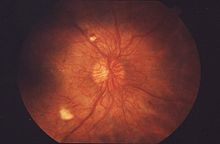- Cotton wool spots
-
Cotton wool spots are an abnormal finding on funduscopic exam of the retina of the eye. They appear as puffy white patches on the retina. They are caused by damage to nerve fibers. The nerve fibers are damaged by swelling in the surface layer of the retina. The cause of this swelling is due to the reduced axonal transport (and hence backlog of intracellular products) within the nerves because of the ischemia.
Diabetes and hypertension are the two most common diseases that cause these spots, and the best treatment would be to treat the underlying disease. In diabetes they are one of the hallmarks of pre-proliferative retinopathy. More rarely, HIV[1] and pancreatitis (Purtscher) retinopathy can also lead to the appearance of cotton wool spots.
References
See also

This medical sign article is a stub. You can help Wikipedia by expanding it.

